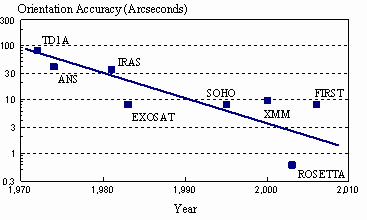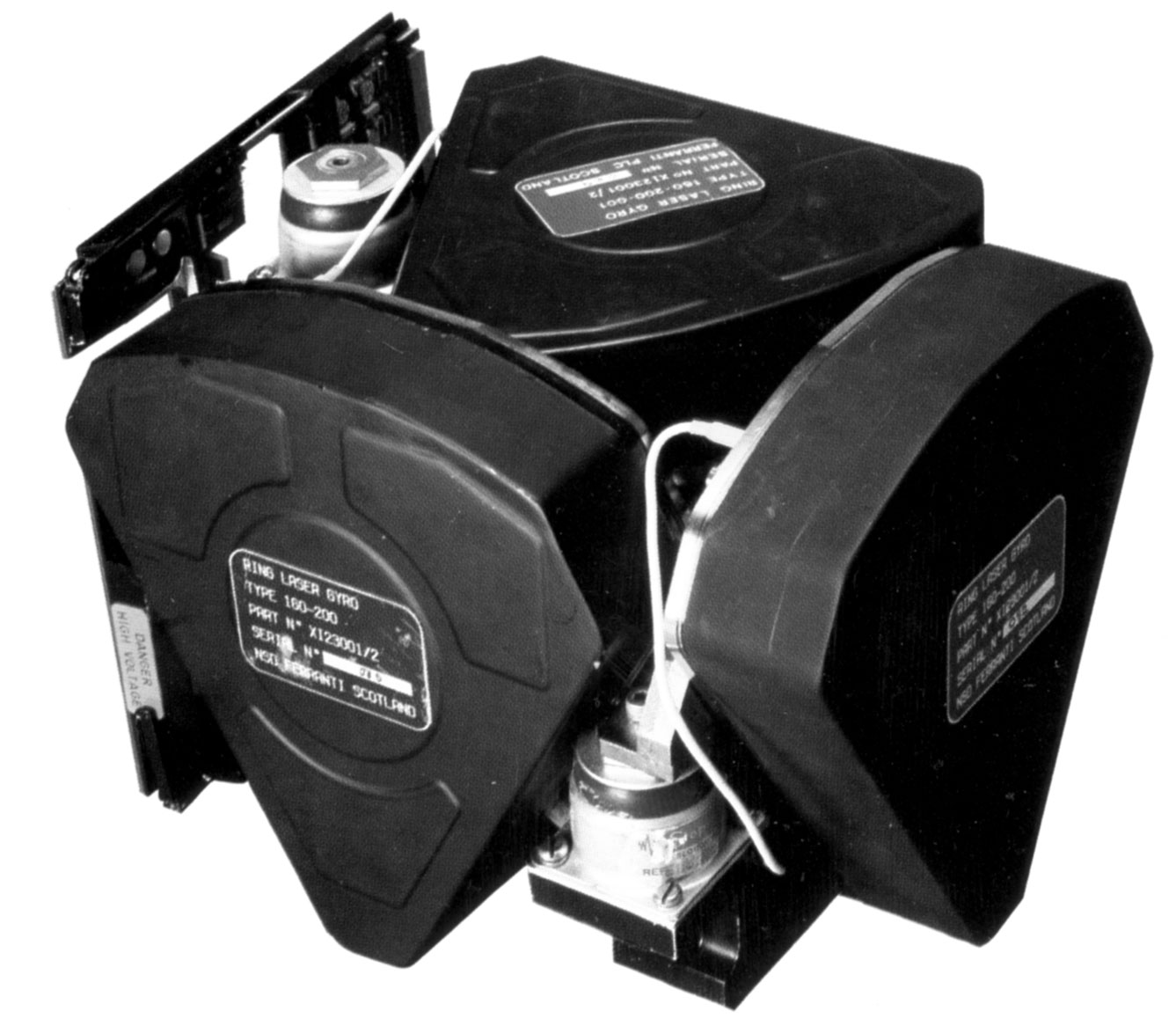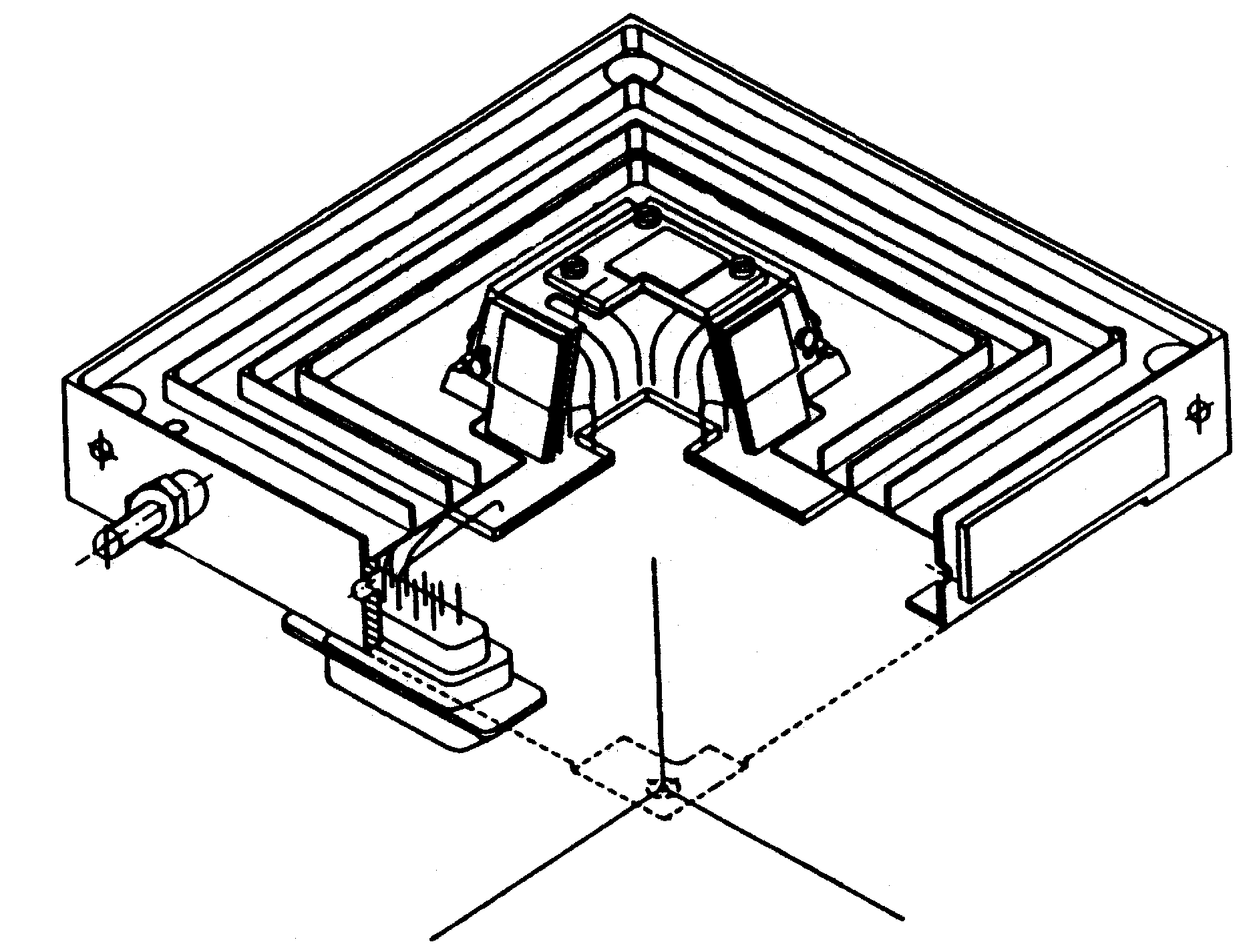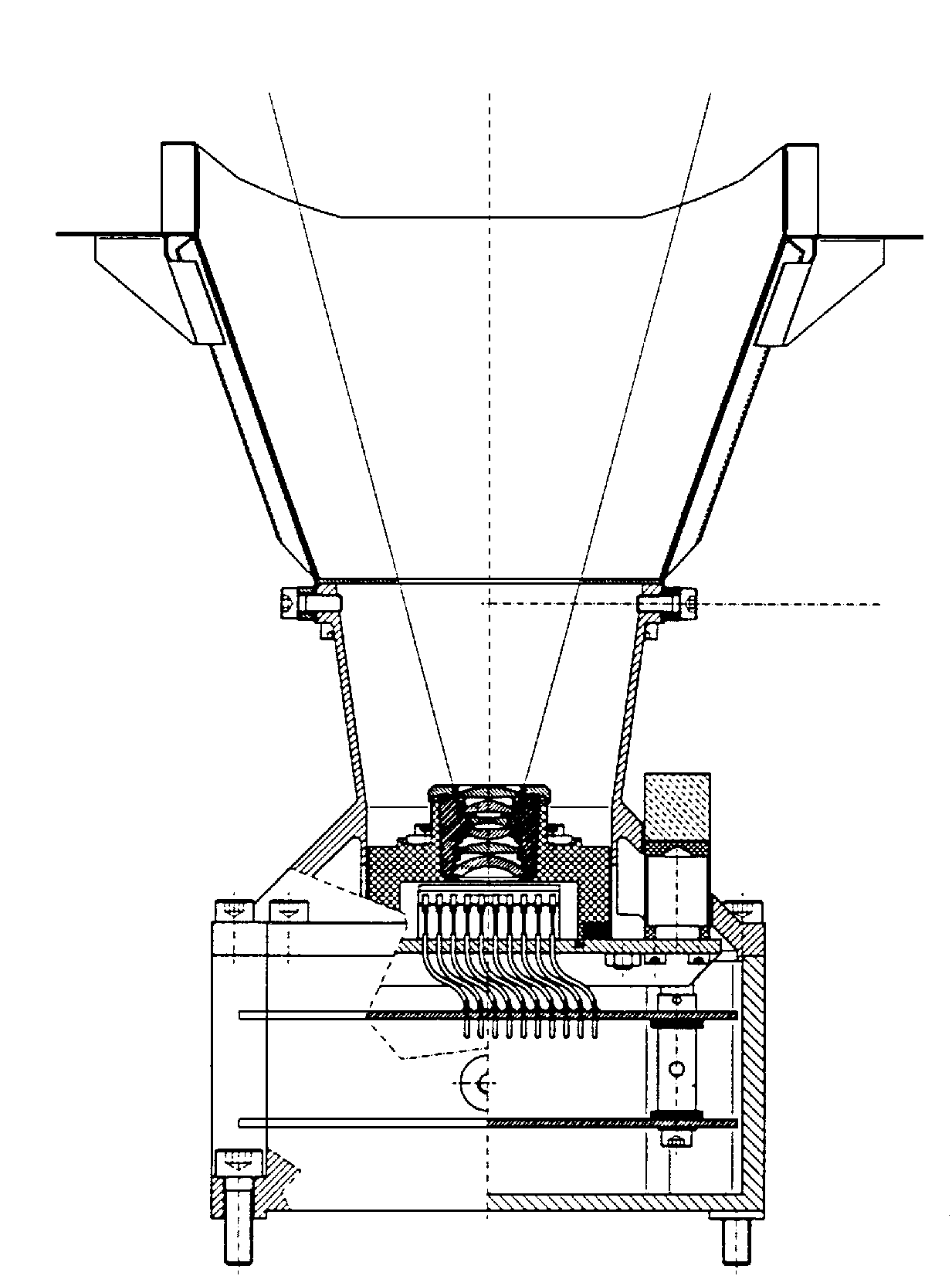Attitude Determination SubsystemSpacecraft attitude determination is the process of estimating the orientation of a spacecraft by making remote observations of other celestial bodies or reference points. Combinations of these sensor observations are used to generate a more accurate estimate of spacecraft rotational attitude. Attitude estimates must be calculated quickly and continuously during the entire operational life of the mission. During normal operations, the problem is recursiveóthe attitude filter basing new predictions on present and prior sensor information. The attitude filter must also estimate from activation when the spacecraft is first initiated and no prior data is available. Since spacecraft orientation will vary with time and task, orientation changes must be tracked, and rates and accelerative torques estimated. The systems designed to carry out 3-axis attitude determination are inevitably complex, but must still be designed with the utmost care to perform the task as reliably as possible. Any, even temporary malfunction is potentially serious, damaging fragile instruments, breaking communications links, upsetting measurements and disrupting power generation. System RequirementsThe role of the attitude determination subsystem is to derive a knowledge of spacecraft rotational orientation for all spacecraft activities to allow effective attitude stabilisation. The activities typically include:
Each activity has specific performance criteria associated with it, usually determined by other requirements. The requirements are often presented in terms of the whole determination and control system, but the attitude determination subsystem performance must clearly be able to meet performance targets at least as well as the total stated system accuracy. During acquisition and slew, systems must be capable of measuring spacecraft spin up to a specified rotation rate, usually related to the maximum permitted launcher release rate (typically a few degrees per second). Coarse and fine control will have carefully specified accuracies, often expressed as the amount the spacecraft angular orientation may deviate around a mean value. For coarse control, pointing accuracy is to within a few degrees. For fine control, pointing accuracy is mission dependent but varies between tenths of a degree to tenths of an arcsec.
Figure 1: Attitude System Performances. While attitude pointing requirements for communications and earth observation type spacecraft have converged to around ›0.1› over the last decade, pointing requirements for science missions have become more demanding. The figure shows the collated performance requirements for science missions with launch dates between 1970 and 2010. While there is pressure for smaller, less expensive spacecraft, as discussed earlier, science mission attitude determination performance requirements have been steadily increasing with each new mission. The whole attitude determination process must also be highly reliable. Estimates must be robust against measurement glitches and spurious signals meeting point requirements throughout the mission. All spacecraft systems must be designed so that they rarely fail, with a statistically estimated failure rate of often less than 1% over the mission life. Above all, the attitude determination subsystem must ensure the safety of the spacecraft in any predicted eventuality, having emergency systems that take control should the main estimation process fail. In the following section we discuss the conventional approaches to meeting the high performance requirements placed on the attitude determination subsystem. Conventional SystemsModern attitude systems carry a variety of different sensor instruments to cover the different modes of operation. Data processing is by a radiation-hardened computer of limited power and memory. Systems adopt a mode-oriented approach using different sensors and algorithms to derive attitude for each spacecraft activity. Changes between certain modes may occur automatically (particularly those associated with acquisition), but most changes are more usually initiated by command from ground. Each mode has a different set of control laws and uses only a subset of the spacecraftís sensors. The overall safety of the spacecraft is protected by an emergency mode, which automatically activates if other control modes fail. Often implemented as an entirely hardwired system, or at least securely partitioned from the main attitude control task in the attitude processor, the emergency mode prevents untimely loss of the spacecraft in the event of failure or glitch (single event up-set). It employs separate sensors ensuring that in the event of a single sensor failure, the spacecraft may be recovered. Attitude determination and control is usually minimal, the system simply locking solar arrays onto the sun, minimising angular rate to prevent damage to deployed booms and sensors, notifying ground control of emergency mode activation and awaiting further instructions. An emergency mode is an important element in the conventional approach to attitude system fault tolerance. Reliability estimates are calculated under the assumption that the attitude system may undergo and recover from a single fault event in one of the system components during the operational lifetime of the spacecraft. To achieve a single event fault tolerance it is common to duplicate the entire attitude subsystem on board the spacecraft. The attitude subsystem in the ISO mission has every essential element doubled or quadrupled, depending on its reliability, and is typical. In the event of a fault in attitude subsystem A, the emergency mode recovers the spacecraft, and the ground control team activates an identical subsystem B. There is also often some cross-strapping of the systems to allow combinations of components from both A and B systems to be used in the event of further failure. The approach of duplicating entire systems is known as numerical redundancy. The disadvantages with the strategy are discussed in a later section. While attitude determination subsystems are designed with a wide variety of requirements, missions and spacecraft, the sensors suites they utilise are often very similar. The following sections describe three categories of sensor devices: rate sensors, coarse pointing sensors and fine pointing sensors. Rate Sensors
Figure 2: A ring laser gyro pack (Bae). For initial acquisition modes, where the spin rate of the spacecraft must be controlled to attain a first inertial lock, sets of rate sensors are employed for each spacecraft axis. Gyroscope devices are widely used. High precision mechanical gyros are common but suffer from high drift rates and are not always reliable. Solid state devices such as ring laser gyros (Figure 2) are increasingly considered for new missions, as are quartz rate sensors. These devices all measure rotational motion around a principal axis. They are usually mounted in the same configuration as reaction wheels in packs of four: in a tetrahedral arrangement or with three mounted orthogonally and a fourth at a skew angle to allow some redundancy to failure. Since their signal must be integrated to give angular position, signal error makes them unsuitable for measuring absolute angles as the measurement will drift with time. Rate measurement is limited to a predetermined range configured to meet the control system specifications. Coarse Pointing SensorsCoarse control is carried out using sun sensors, simple devices consist of solar cells and baffles. A crude estimate of sun incidence angle is derived from the differential voltages generated by opposing cells (Figure 3). They are often used as part of the hardwired emergency sun re-acquisition system, dedicated to re-aligning the spacecraft with the sun when the main control mode fails.
Figure 3: A Coarse Sun Sensor (Engineering diagram TPD Ltd.). Spacecraft also utilise other bright objects such, as the earth or bright stars, for crude attitude calculation. Earth sensors scan the sky detecting the planet edges by thermal emission. Orientation information is generated to approximately 0.05›, but larger errors can be caused by anomalous atmospheric conditions. Crude star sensors record the position of a particular pre-determined bright celestial body, using its location to align spacecraft axes. These instruments are used for coarse attitude stabilisation, after acquisition. The Global Position System (GPS) is also finding increasing application in spacecraft. With two antennae, satellites in earth orbit may not only locate position, but also calculate orientation. The system is limited to systems requiring only a crude attitude lock (›0.5o), but is inexpensive and uses well proven technology. Fine Pointing SensorsFine pointing control is almost invariably by star camera. Recently, designs have converged towards simple camera systems recording 2D images using a Charged Coupled Device (CCD) chip (similar to those used in modern video cameras). An optical arrangement consisting of two or three lenses images starlight entering the camera onto the surface of the CCD (Figure 4). The CCD captures the view as a grid of pixels of varying intensities ready for processing. It is sometimes cooled to minimise thermal noise and thereby to improve resolution. The optics often deliberately defocus the image to allow star centroid determinationóthe accurate location of each star to sub-pixel precision. Image frames are processed by a dedicated computer deriving star movement information or star position and brightness information, depending on the mode of operation. Algorithms are simple, incapable of tracking more than a few stars or movements above fractions of a pixel. Small onboard catalogues are occasionally used for comparison with images, but absolute location is almost always carried out on the ground. Accuracies for star-camera type instruments are quoted between 1 and 100 (3ů ) arcsec for principal axes dependent on the number of CCD pixels, the size of the field-of-view and the amount of star-centroid location determination.
Figure 4: A Medium Accuracy Star Tracker 30ox40o Field of View (Alenia Spazio). A typical example of one of the higher accuracy devices is the Officine Galileo Startracker used on a number of spacecraft. It consists of a Peltier cooled CCD array (384› 288 pixels) looking at a 4.2› 3.16› segment of the sky. Large baffles prevent stray reflections entering the optics and allow observation of star positions up to a quoted minimum 55› angle from the sun. An optical arrangement (focal length 0.12m) produces a defocused image of a small portion of the celestial sphere, blurring star images to a 3› 3 pixel segment of the array. Analogue electronics sum the outputs of each pixel over an integration period (typically 0.5 seconds), and an electronic thresholding circuit reduces the amount of pixel data passed to the deviceís processor. The processor implements a star-centroid locating algorithm and crude tracking algorithms, magnifying the raw instrument pixel star position by a factor of 166 to give positions on a 63744› 47808 grid (quantised to 0.24 arcsec). A worst case noise analysis quotes a standard deviation of 2.2 arcsec for attitude determination tracking five known stars. The device is reported to be able to map and track stars in the field of view to a limiting magnitude of +8. Data Processing and Sensor FusionTo calculate spacecraft attitude, information from different sensors must be fused together to form one coherent estimate. The problem is again often broken into modes, different sensor data and fusing techniques being used by different control modes. During slew control, spacecraft rate is observed usually solely by gyroscope or rate sensor, either used directly or lightly filtered to remove some sensor noise without introducing large lags in instrument response. Some simple post-processing calculates orthogonal rates of rotation in the spacecraft frame from non-orthogonally mounted sensors. System response is occasionally improved by the integration of accelerometer data with rate data directly sensing the impulses applied to the spacecraft. Since thruster impulses can be adequately quantified, only very basic rate determination is required. Coarse pointing attitude determination also uses minimal processing. Since spacecraft attitude need only be maintained approximately, the simplest determination and control strategies are adopted to align the spacecraft axes relative to the sun or earth. Methods are deterministicóusing the minimum sensor information required to resolve attitude at every iteration. The calculation of fine pointing attitude is usually the only non-deterministic determination mode. The most common approach is to use some kind of state estimator (usually a Kalman filter), deriving time evolving estimates of the parameters critical to attitude. Predictions of current attitude based on prior sequences of attitude sensor information are implemented to generate much more precise estimates than calculations based solely on current raw attitude data. In addition to increasing accuracy by up to an order of magnitude, current attitude predictions may be generated using prior data sequences when it is impossible to derive an estimate based on current sensor information alone. Increasingly, Kalman Filter estimators (or derivatives) are employed to generate attitude predictions based on linear models of sensor and spacecraft dynamics. Traditionally, filter parameters or gain weights are calculated and updated on the ground and communicated to the spacecraft. The spacecraft uses a fixed gain Kalman type filter with the pre-calculated gains to weight sensor information correctly in the attitude estimate. Some more modern attitude determination subsystems implement variable gain filters to speed the convergence of estimates. The ENVISAT spacecraft (due to be launched 1999) employs a star sensor based attitude determination system with six variable states to increase convergence after viewing empty areas of sky. Assumptions Made by Conventional SystemsTo implement conventional design philosophies, the designer must sacrifice sophistication and performance for simplicity. Two areas where this trade-off is most apparent is in the design of attitude estimators and the approach to fault tolerance. These compromises are best summarised by the following design assumptions:
These assumptions are implicit in the design of even the most modern of current spacecraft attitude subsystem designs. The modelling restrictions make systems easy to design and analyse. System hardware may be fabricated using basic components with a well established heritage. The prevailing approach to fault tolerance makes reliability quantifiable, minimising the probability of random error. Assuming that the simple spacecraft systems can be designed flawlessly, reliability calculations reduce to a simple component by component analysis. However, this conventional design approach has a number of disadvantages that are becoming increasingly evident as system performance specifications increase. The restrictive modelling assumptions prevent systems from making the best use of sensor data. This drives up the number of instruments and modes required to build an attitude determination system, increasing system mass and cost. It also limits the overall system performanceóa limitation that can make conventional design unsuitable for missions with particularly challenging requirements. The approach to fault tolerance, combined with the need for simple design, leads to systems that make heavy use of numerical redundancy, largely ignoring the probability of failures caused by design flaws. This again drives up cost and mass and also places considerable reliance on an emergency mode. New ApproachesAs missions become more demanding, new approaches to the design of spacecraft systems are being researched. New techniques are beginning to change spacecraft design philosophy. The two key areas under development are:
These approaches are the subject of active research and development by space companies and universities worldwide. Some recent work is discussed in other sections of this site. References
|
||||||||||||||||||||



